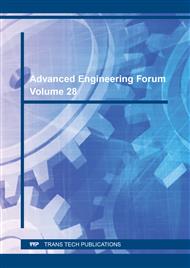[1]
Manoranjan Paul, Shah ME Haque, and Subrata Chakraborty. Human detection in surveillance videos and its applications-a review. EURASIP Journal on Advances in Signal Processing, 2013(1):1-16, (2013).
DOI: 10.1186/1687-6180-2013-176
Google Scholar
[2]
PalwashaAfsar, Paulo Cortez, and Henrique Santos. Automatic visual detection of human behavior: A review from 2000 to 2014. Expert Systems with Applications, 42(20):6935-6956, (2015).
DOI: 10.1016/j.eswa.2015.05.023
Google Scholar
[3]
Oluwatoyin P Popoola and Kejun Wang. Video-based abnormal human behavior recognition-a review. Systems, Man, and Cybernetics, Part C: Applications and Reviews, IEEE Transactions on, 42(6):865-878, (2012).
DOI: 10.1109/tsmcc.2011.2178594
Google Scholar
[4]
Tracey K. M. Lee, Mohammed Belkhatir, and Saeid Sanei. A comprehensive review of past and present vision-based techniques for gait recognition. Multimedia Tools and Applications, 72(3):2833-2869, (2013).
DOI: 10.1007/s11042-013-1574-x
Google Scholar
[5]
Dimitios Makris and Tim Ellis. Learning semantic scene models from observing activity in visual surveillance. Systems, Man, and Cybernetics, Part B: Cybernetics, IEEE Transactions on, 35(3):397-408, (2005).
DOI: 10.1109/tsmcb.2005.846652
Google Scholar
[6]
Saeed Shhy Ghidary, Yasushi Nakata, Toshi Takamori, and Motofumi Hattori. Human detection and localization at indoor environment by home robot. In Systems, Man, and Cybernetics, 2000 IEEE International Conference on, volume 2, pages 1360-1365. IEEE.
DOI: 10.1109/icsmc.2000.886043
Google Scholar
[7]
Chris Stauffer and W Eric L Grimson. Adaptive background mixture models for real-time tracking. In Computer Vision and Pattern Recognition, 1999. IEEE Computer Society Conference on., volume 2. IEEE.
DOI: 10.1109/cvpr.1999.784637
Google Scholar
[8]
Berthold K.P. Horn and Brian G. Schunck. Determining optical flow. Artificial Intelligence, 17(1):185 - 203, (1981).
DOI: 10.1016/0004-3702(81)90024-2
Google Scholar
[9]
Yannick Benezeth, Pierre-Marc Jodoin, Bruno Emile, Hélene Laurent, and Christophe Rosenberger. Comparative study of background subtraction algorithms. Journal of Electronic Imaging, 19(3):033003-033003-12, 2010.RETRACTED[10] Imad Rida, Ahmed Bouridane, Gian Luca Marcialis, and Pierluigi Tuveri. Improved human gait recognition. In International Conference on Image Analysis and Processing, pages 119-129. Springer, (2015).
DOI: 10.1117/1.3456695
Google Scholar
[11]
LiangWang,TieniuTan, Huazhong Ning, andWeiming Hu. Silhouette analysis-based gait recognition for human identification. IEEE Transactions on Pattern Analysis and Machine Intelligence, 25(12):1505-1518, (2003).
DOI: 10.1109/tpami.2003.1251144
Google Scholar
[12]
Y. Ran, Q. Zheng, R. Chellappa, and T. M. Strat. Applications of a simple characterization of human gait in surveillance. IEEE Transactions on Systems, Man, and Cybernetics, Part B (Cybernetics), 40(4):1009-1020, (2010).
DOI: 10.1109/tsmcb.2010.2044173
Google Scholar
[13]
Xingyu Zeng, Wanli Ouyang, Meng Wang, and Xiaogang Wang. Deep learning of scene-specific classifier for pedestrian detection. In European Conference on Computer Vision, pages 472-487. Springer, (2014).
DOI: 10.1007/978-3-319-10578-9_31
Google Scholar
[14]
Joseph Redmon, Santosh Divvala, Ross Girshick, and Ali Farhadi. You only look once: Unified, real-time object detection. In Proceedings of the IEEE Conference on Computer Vision and Pattern Recognition, pages 779-788, (2016).
DOI: 10.1109/cvpr.2016.91
Google Scholar
[15]
A. Kale, A. Sundaresan, A. N. Rajagopalan, N. P. Cuntoor, A. K. Roy-Chowdhury, V. Kruger, and R. Chellappa. Identification of humans using gait. IEEE Transactions on Image Processing, 13(9):1163-1173, (2004).
DOI: 10.1109/tip.2004.832865
Google Scholar
[16]
Ibrahim Venkat and Philippe De Wilde. Robust gait recognition by learning and exploiting subgait characteristics. International Journal of Computer Vision, 91(1):7-23, (2011).
DOI: 10.1007/s11263-010-0362-6
Google Scholar
[17]
Chiraz BenAbdelkader, Ross Cutler, Harsh Nanda, and Larry Davis. Eigengait: Motion-based recognition of people using image self-similarity. In Audio-and Video-Based Biometric Person Authentication, pages 284-294. Springer.
DOI: 10.1007/3-540-45344-x_42
Google Scholar
[18]
S. Sarkar, P. J. Phillips, Z. Liu, I. R. Vega, P. Grother, and K. W. Bowyer. The humanid gait challenge problem: data sets, performance, and analysis. IEEE Transactions on Pattern Analysis and Machine Intelligence, 27(2):162-177, (2005).
DOI: 10.1109/tpami.2005.39
Google Scholar
[19]
C. BenAbdelkader, R. Cutler, and L. Davis. Stride and cadence as a biometric in automatic person identification and verification. In Automatic Face and Gesture Recognition, 2002. Proceedings. Fifth IEEE International Conference on, pages 372-377.
DOI: 10.1109/afgr.2002.1004182
Google Scholar
[20]
Hironobu Fujiyoshi and Alan J Lipton. Real-time human motion analysis by image skeletonization. In Proceedings of the 4th IEEE Workshop on Applications of Computer Vision (WACV'98), page 15. IEEE Computer Society, (1998).
DOI: 10.1109/acv.1998.732852
Google Scholar
[21]
S. A. Niyogi and E. H.Adelson. Analyzing and recognizing walking figures in xyt. In Computer Vision and Pattern Recognition, 1994. Proceedings CVPR '94., 1994 IEEE Computer Society Conference on, pages 469-474.
DOI: 10.1109/cvpr.1994.323868
Google Scholar
[22]
Bridget Burdett. Measuring accessible journeys. Report, Traffic Design Group, July (2013).
Google Scholar
[23]
Casia gait database, http://www.cbsr.ia.ac.cn/english/gait%20databases.asp.
Google Scholar
[24]
Zhe Cao, Tomas Simon, Shih-En Wei, and Yaser Sheikh. Realtime multi-person 2d pose estimation using part affinity fields. arXiv preprint arXiv:1611.08050, 2016.RETRACTED.
DOI: 10.1109/cvpr.2017.143
Google Scholar


